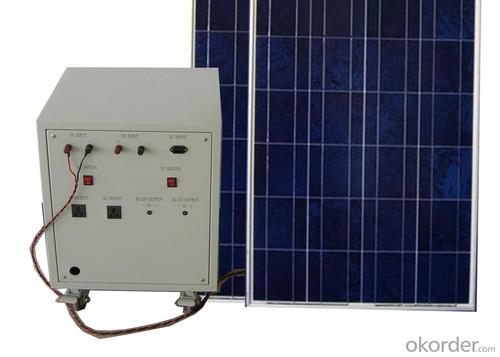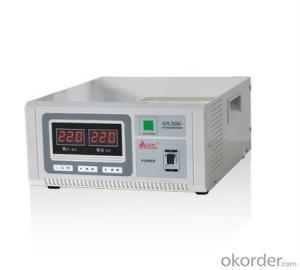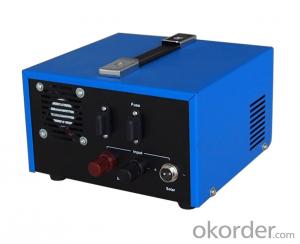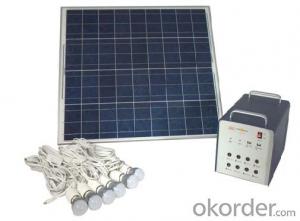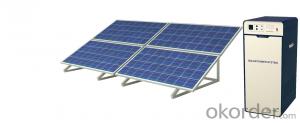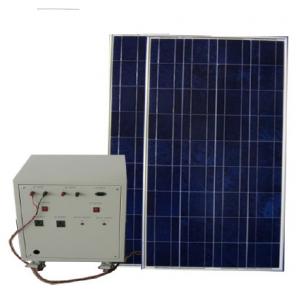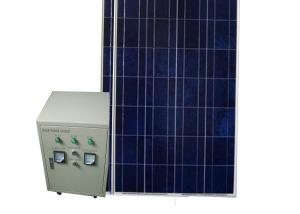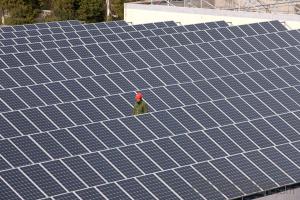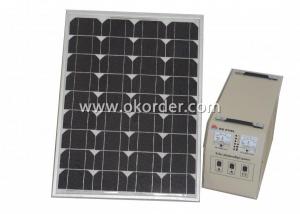Solar Energy Systems Penrith - CNBM Solar Home System CNBM-K3 (200W)
- Loading Port:
- China Main Port
- Payment Terms:
- TT or L/C
- Min Order Qty:
- 1 set set
- Supply Capability:
- 1000 sets per month set/month
OKorder Service Pledge
OKorder Financial Service
You Might Also Like
Brief Introduction of Solar Energy System CNBM-K3 (200W)
CNBM International is highly recognized by its business partners and clients all over the world and has obtained rapid development under the spirit of win-win .With CNBM HomeSystem-K3(200W),
We will carry on the mutual beneficial,innovative and revolutionary trading structure as we did before,
create value for our employees,share holders and clients and benefit the whole society in our future development.Please contact us ,if
you have interest in CNBM Home System-K3 (200W),don’t hesitate!
The Sketching of Solar Energy System CNBM-K3 (200W)
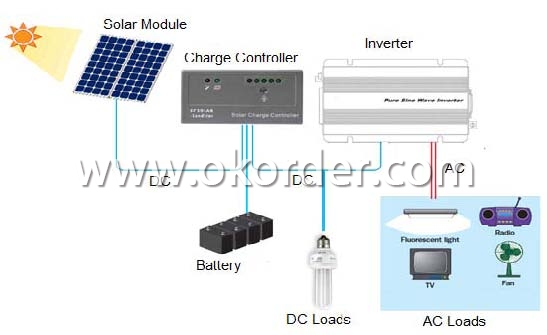
Components of Solar Energy System CNBM-K3 (200W)
PV Array:
Convert sunlight instantly into DC electric power. Formed by the solar modules (also called photovoltaic modules) in accordance with the system requirements for series and parallel.
Solar Charge Controller:
A charge controller may be used to power DC equipment with solar panels. The charge controller provides a regulated DC output and stores excess energy in a battery as well as monitoring the battery voltage to prevent over charge or over discharge. An inverter can be connected to the output of a charge controller to drive AC loads.
Inverter:
Converts DC output power of photovaltaic soalr panels into standard AC power for use in the local off-grid electrical network. It is a critical component in a photovoltaic system, allowing the use of ordinary commercial appliances.
Battery banks:
Stores energy when there is an excess coming in and distribute it back out when there is a demand. Solar PV panels continue to re-charge batteries each day to maintain battery charge.
Technical data of Solar Home System CNBM-K3 (200W) | ||
Inverter | Rated load power | 500W |
Output wave | Pure sine wave | |
Output voltage | DC 24V | |
Output frequency | DC:12V AC:220V | |
Precision of output | 50HZ/60HZ | |
Precision of output frequency | ±6% | |
Solar panel | Pmax | 100W*2PCS |
Vmp | 18.4V*2 | |
Imp | 5.44A | |
Charger | Charger voltage & current | 24V 10A |
Battery | Capacity | 12V 50AH*2 |
Power box | Spray paint iron box,with input,output,ammeter,voltmeter,master swith and so on. | |
Package of Solar Home System CNBM-K3 (200W) | ||||
Part | Size(L*W*H mm) | Weight(kg) | 20’(pcs) | 40’(pcs) |
Power box | 580*520*540 | 60 | 96 Sets | 240 Sets |
Solar panel | 1120*670*30 | 17 | ||
Battery | 230*310*220 | 40 | ||
Factory Picture of Solar Energy System CNBM-K3 (200W)
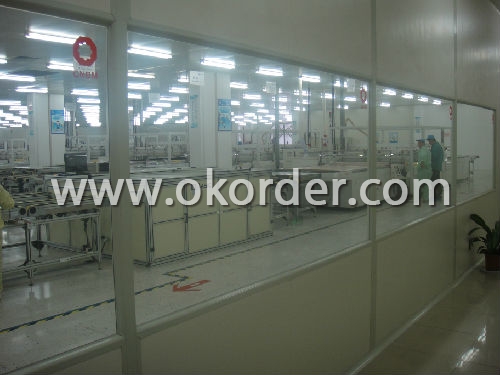
Package Picture of Solar Energy System CNBM-K3 (200W)
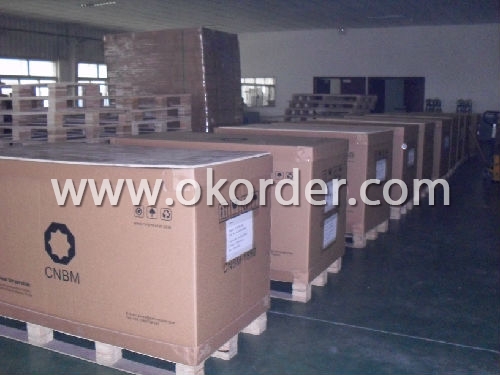
- Q: Can solar energy systems work during cloudy or rainy days?
- Solar energy systems can still work during cloudy or rainy days, although their efficiency may be reduced. While direct sunlight is the most effective way to generate solar energy, even diffused sunlight on cloudy or rainy days can still produce a certain amount of electricity.
- Q: Can a solar energy system be installed on a gas station or convenience store?
- Yes, a solar energy system can be installed on a gas station or convenience store. In fact, many gas stations and convenience stores have already installed solar panels to reduce their energy costs and promote sustainability. Solar energy systems can be mounted on the rooftops of these buildings or installed in nearby open spaces. These systems can generate electricity that can be used to power the store's lighting, refrigeration systems, and other electrical appliances. Additionally, excess electricity generated by the solar panels can be fed back into the grid, allowing the gas station or convenience store to earn credits or revenue through net metering or feed-in tariff programs. Installing a solar energy system on a gas station or convenience store not only helps in reducing energy bills but also showcases the business's commitment to renewable energy and reduces its carbon footprint.
- Q: Are there any risks of electrical malfunction or failure with solar energy systems?
- Yes, there are some risks of electrical malfunction or failure with solar energy systems. One of the main risks is a faulty or damaged electrical connection, which can result in a loss of power generation or even electrical fires. Additionally, extreme weather conditions such as lightning strikes or strong winds can damage the solar panels or inverters, leading to a temporary or permanent failure of the system. Another risk is the degradation of solar panels over time, which can result in decreased efficiency and eventually require replacements. Furthermore, improper installation or maintenance can lead to system failure or electrical malfunctions. It is essential to ensure that solar energy systems are installed by qualified professionals and regularly inspected and maintained to minimize these risks.
- Q: Are there any safety certifications required for solar energy systems?
- Yes, there are safety certifications required for solar energy systems. In most countries, solar energy systems must meet certain safety standards and regulations before they can be installed and used. These certifications ensure that the solar panels, inverters, and other components of the system are manufactured and installed in a way that minimizes the risk of electrical hazards, fire, and other safety issues. One of the most common safety certifications for solar energy systems is the International Electrotechnical Commission (IEC) 61730 standard. This certification ensures that the solar panels meet specific safety requirements, including mechanical strength, resistance to environmental factors, and electrical insulation. It also includes tests for fire resistance, which is crucial to prevent potential hazards. Additionally, solar inverters, which convert the direct current (DC) generated by solar panels into the alternating current (AC) used in homes and businesses, also require safety certifications. The most widely recognized certification for inverters is the IEC 62109 standard, which verifies that the inverters meet safety requirements such as electrical insulation, protection against overvoltage and overcurrent, and proper grounding. Furthermore, the installation of solar energy systems must comply with local electrical and building codes, which often include safety requirements. These codes ensure that the system is installed correctly and safely, with proper wiring, grounding, and protection against electrical faults. It's important for solar energy system manufacturers, installers, and users to adhere to these safety certifications and regulations to ensure the safe and reliable operation of solar energy systems. By doing so, the risk of electrical accidents, fires, and other safety hazards can be minimized, providing peace of mind to both the system owners and the surrounding community.
- Q: Can solar energy systems be used in powering beauty salons or spas?
- Yes, solar energy systems can definitely be used to power beauty salons or spas. Solar energy is a renewable and sustainable source of power that can help reduce the dependence on grid electricity and minimize the carbon footprint of these establishments. By installing solar panels on the roof or other suitable areas, beauty salons and spas can generate their own electricity and reduce their energy costs in the long run. Beauty salons and spas typically require a significant amount of electricity to operate hair dryers, hair straighteners, curling irons, lighting, air conditioning, and other equipment. Solar energy systems can easily meet these power demands, especially during daylight hours when the sun is shining. Excess electricity generated during the day can be stored in batteries or fed back into the grid, ensuring a continuous supply of power at all times. Moreover, solar energy systems can help improve the sustainability and environmental performance of beauty salons and spas. By switching to solar power, these establishments can significantly reduce their carbon emissions and contribute to the fight against climate change. Additionally, using solar energy can help attract environmentally conscious customers who appreciate businesses that prioritize sustainability. In summary, solar energy systems are a viable option for powering beauty salons and spas. They can provide a reliable and sustainable source of electricity, reduce energy costs, and contribute to a greener and more environmentally friendly business operation.
- Q: How does solar energy impact the environment?
- Solar energy has a positive impact on the environment as it is a clean and renewable source of energy. By harnessing the power of the sun, solar energy reduces greenhouse gas emissions, air pollution, and dependence on fossil fuels. Additionally, it helps in conserving valuable resources and mitigating climate change, making it a sustainable and eco-friendly option for meeting our energy needs.
- Q: Can solar energy systems be used for space heating?
- Yes, solar energy systems can be used for space heating. Solar thermal systems can capture and convert sunlight into heat energy, which can then be used to heat spaces in buildings. These systems typically involve solar collectors that absorb solar radiation and transfer the heat to a fluid or air, which is then circulated through the building to provide heating. Solar energy can be a cost-effective and sustainable solution for space heating, particularly in areas with abundant sunshine.
- Q: What is the role of solar energy systems in reducing reliance on fossil fuels?
- Solar energy systems play a crucial role in reducing reliance on fossil fuels by harnessing the power of the sun to generate clean and renewable electricity. These systems convert sunlight into usable energy, reducing the need for traditional energy sources like coal, oil, and natural gas. By adopting solar energy, we can decrease greenhouse gas emissions, combat climate change, and move towards a more sustainable and environmentally friendly future.
- Q: Can solar energy systems be installed in urban areas with limited space?
- Yes, solar energy systems can be installed in urban areas with limited space. While it is true that urban areas often have limited rooftop space available for solar panel installation, there are several innovative solutions that can be implemented to overcome this challenge. One option is the installation of solar panels on vertical surfaces such as walls or facades of buildings. This approach maximizes the use of available space and does not require additional land. By utilizing vertical space, solar energy systems can still generate a significant amount of electricity even in densely populated urban areas. Another solution is the implementation of community solar projects. These projects involve the installation of solar panels in a centralized location within the urban area, such as a parking lot or a vacant lot. The electricity generated by these panels can then be shared among multiple buildings or households, allowing those with limited rooftop space to still benefit from solar energy. Furthermore, technological advancements have led to the development of more efficient and compact solar panels. These panels can generate the same amount of electricity as traditional panels with less surface area, making them more suitable for installation in limited urban spaces. In addition to these solutions, it is important to consider the potential for solar energy systems to be integrated into existing infrastructure. For example, solar panels can be installed on top of bus stops, streetlights, or even on the sides of bridges and highways. This allows for the utilization of spaces that would otherwise remain unused. Overall, while limited space may pose a challenge, there are various ways to install solar energy systems in urban areas. With innovative approaches and advancements in technology, solar power can be harnessed even in densely populated cities, contributing to a more sustainable and renewable energy future.
- Q: What is the lifespan of solar panels?
- The average lifespan of solar panels is typically around 25 to 30 years, although some panels can last even longer with proper maintenance and care.
Send your message to us
Solar Energy Systems Penrith - CNBM Solar Home System CNBM-K3 (200W)
- Loading Port:
- China Main Port
- Payment Terms:
- TT or L/C
- Min Order Qty:
- 1 set set
- Supply Capability:
- 1000 sets per month set/month
OKorder Service Pledge
OKorder Financial Service
Similar products
Hot products
Hot Searches
Related keywords



